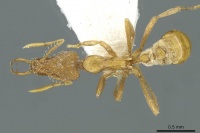Strumigenys hindu
| Strumigenys hindu | |
|---|---|

| |
| Scientific classification | |
| Kingdom: | Animalia |
| Phylum: | Arthropoda |
| Class: | Insecta |
| Order: | Hymenoptera |
| Family: | Formicidae |
| Subfamily: | Myrmicinae |
| Tribe: | Attini |
| Genus: | Strumigenys |
| Species: | S. hindu |
| Binomial name | |
| Strumigenys hindu De Andrade, 2007 | |
Nothing is known about the biology of Strumigenys hindu.
Identification
Baroni Urbani & De Andrade (2007) - A member of the godeffroyi complex in the Strumigenys godeffroyi-group. Resembling Strumigenys uberyx and Strumigenys buddhista but differing from these two species by its larger size (TL = 2.S mm instead of 1.8-1.9 mm) and by the SI = 102.6 (instead of ≤ 91).
S. hindu, uberyx and buddhista are very similar to each other but the characters listed in their respective species diagnosis separate them clearly.
Distribution
Distribution based on Regional Taxon Lists
Oriental Region: Nepal (type locality).
Distribution based on AntMaps
Distribution based on AntWeb specimens
Check data from AntWeb
Countries Occupied
| Number of countries occupied by this species based on AntWiki Regional Taxon Lists. In general, fewer countries occupied indicates a narrower range, while more countries indicates a more widespread species. |

|
Estimated Abundance
| Relative abundance based on number of AntMaps records per species (this species within the purple bar). Fewer records (to the left) indicates a less abundant/encountered species while more records (to the right) indicates more abundant/encountered species. |

|
Biology
Castes
Nomenclature
The following information is derived from Barry Bolton's Online Catalogue of the Ants of the World.
- hindu. Strumigenys hindu De Andrade, in Baroni Urbani & De Andrade, 2007: 156, fig. 54 (w.) NEPAL.
Unless otherwise noted the text for the remainder of this section is reported from the publication that includes the original description.
Description
Worker
TL 2.50; HL 0.62; HW 0.38; SL 0.39; ML 0.26; EL 0.03; WL 0.66; CI 61.3; S1 102.6; MI 41.9.
Head sides converging anteriorly, with round vertexal corners. Frontal lobes weakly expanded and convex. Antennal fossae ventrally with a marked carina visible in full-face view, straight, covering the lower margin of the scrobes and ending close to the eyes. Eyes small, with 2 ommatidia in the longest row, placed over the ventral margin of the antennal scrobes, and slightly visible in dorsal view. With the head in profile the scrobe distinct, with superficially marked upper and lower margins. Clypeal dorsum gently concave medially. Lateral clypeal margin gently converging anteriorly into a straight margin. Scapes subcylindrical, about 2/3 of the head length and surpassing the eyes posteriorly. Antennae with six joints. Apical funicular joint much longer than the rest of the funiculus. Mandibles curved. Apical fork of the mandibles with two spiniform teeth and with two intercalary denticles. Preapical dentition consisting of one spiniform tooth near the apex.
Mesosoma in profile weakly convex anteriorly and sloping posteriorly into the gently convex basal face of the propodeum. Propodeal teeth pointed and ventrally connected to a medially convex lamella.
Petiole with a long neck and with the node high, dorsally almost flat and anteriorly tumuliform. Ventral surface of the petiole with a broad spongiform lamina. Petiolar node with posterior margin and whole sides surrounded by spongiform process. Postpetiole gently convex in side view. Anterior, lateral and posterior margins of the postpetiole surrounded by spongiform processes. Ventral surface of the postpetiole with large and dense spongiform process.
Gaster oval and with thin, short costulae. Base of the first gastral tergite and sternite with spongiform pad larger on the tergite.
Sculpture. Head reticulate and minutely punctuate. Pronotum, pleurae and declivous face of the propodeum smooth. Mesonotum, basal face of the propodeum and petiole punctuate, the punctures fainter and sparser on the petiole. Postpetiole and gaster smooth.
Pilosity. Head, mesosoma, petiole and postpetiole with appressed, thin hairs. Dorsolateral margin of the head in full-face view with the apicoscrobal flagellate hair only. Cephalic dorsum with three rows of erect hairs, the first row with 4 hairs close to the occipital margin, the second row with 4 standing hairs and the third row with 2 hairs on the frons. Upper scrobal margin with narrow spoon-shaped hairs curved anteriorly. Clypeal border with hairs similar to those of the upper scrobe. Scapes with hairs also similar to those on the upper scrobes and curved posteriorly. Pronotal humeral hairs long and flagellate. Dorsum of the pronotum with a pair of erect long hairs. Mesonotum with a pair of erect flagellate hairs. Petiole, postpetiole and gaster with few erect flagellate hairs. Dorsal face of hind femora with an erect fine hair on the basal third. Outer face of mid and hind tibiae with an erect, long flagellate hair. Hind basitarsi with 1-2 pairs of erect, long flagellate hairs.
Colour. Light brown.
Type Material
Holotype worker (unique) from Nepal labelled: Pokhara, 820 m, 15-18.VI.1970, Nepal, W. Wittmer, C. Baroni Urbani (Naturhistorisches Museum, Basel).
Etymology
The Hindu religion, one of the two major religions of Nepal is used here as a noun in apposition.
References
- [[Media:Baroni Urbani & Andrade 2007.pdf| Baroni Urbani, C. & De Andrade, M.L. 2007. The ant tribe Dacetini: limits and constituent genera, with descriptions of new species. Annali del Museo Civico di Storia Naturale “G. Doria” 99*Subedi, I.P., Budha, P.B. 2019. Status of ant research and species first described from Nepal with new distribution records. Journal of Natural History Museum. 31:57-78.
- 1-191.]]

